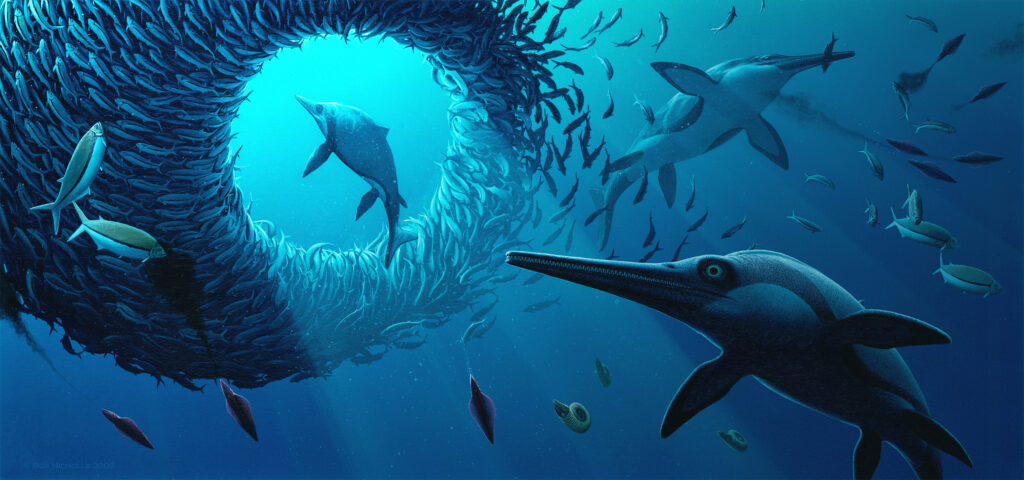Exploring Prehistoric Waters
When people hear the word “Jurassic,” perhaps one of the first things that come to mind is the T-Rex, that imposing giant that ruled the lush lands of pre-historic Earth. Perhaps your mind envisions the sprawling pterodactyl scaling the skies and swooping down to snatch up its prey. Thanks to Steven Spielberg and a not-so-small contingent of Hollywood production studios that have brought the dinosaur age to life on the big screen, anybody that hasn’t lived under a rock for the past 20 years has an incredibly vivid picture to conjure when it comes to imagining Jurassic life. And yet that image is truly only part of the picture of life in Jurassic times.
This winter, The Field Museum is bringing Chicagoans an exhibition that aims to broaden their understanding of pre-historic creatures and the kinds of life that inhabited our world. Jurassic Oceans: Monsters of the Deep, gives visitors an opportunity to take a deep dive into the other side of the world imagined in films like Jurassic Park. Opening this past February, Jurassic Oceans takes visitors on an incredible underwater journey to encounter some of Sue the T-Rex’s fascinating neighbors that ruled the deepest oceans of pre-historic times.
Featuring over 100 fossils and models ranging from giant reptiles that resemble real-life versions of Lock Ness Monster to small, strange sea lilies (cousins to the modern-day starfish), this new show takes a giant step toward revealing the great depth and breadth of the diverse marine life found in Jurassic times. And thanks to state-of-the-art CGI projections, we get a prime opportunity to come face-to-face with some of the most ferocious marine predators of the Jurassic seas without risk to life and limb—that along with other of the more friendly variety, of course (think Finding Nemo, only strangely cute).
And that’s really one of the most impressive features of this exhibition, that guests will get a chance to do more than simply view these creatures from a distance. Visitors will get up-close-and-personal with Jurassic sea life in a visceral experience that educates and expands our understanding of the period we think we already know. That visceral element is one that the museum’s team is most enthusiastic about granting visitors to the Field this winter. Says Emily Parr, the exhibition’s project manager, “We’re excited to showcase these amazing encounters and let visitors experience the incredible diversity of the Jurassic oceans.” The public will be able to touch real fossils of shelled creatures from the Jurassic, feel the textures of replicated sea creature skins, and finder further opportunities to explore the features of marine reptiles on interactive touchscreens.
On view in the exhibition, which was produced and curated by London’s Natural History Museum, is a true-to-life replica of an ichthyosaur, a sleek and speedy reptile you wouldn’t want to encounter on your next trip to the coast. There’s the skeletal view of a long-necked plesiosaur; and a fossilized tail of one of the largest fish ever discovered, the Leedsichthys, a thirty-foot-long giant that cruised near the surface hunting thousands of microsconic plankton. Museumgoers will also get to see real specimens of today’s marine reptiles: crocodiles, sea snakes, sea turtles, water monitors, and marine iguanas.
For, Lottie Dodwell, an interpretation developer at London’s Natural History Museum, who worked on the exhibition, this exhibition gives creatures of the Jurassic Deep an important opportunity to get equal playing time with their land-based counterparts we’ve come to know so well. Said Dodwell, “I hope visitors will get to know some of the animals that dominated our oceans for 160 million years, and learn that dinosaurs weren’t the only impressive reptiles around in the Jurassic.”
Doug Gurr, Director of the Natural History Museum, sees an even more pressing benefit to the focus the exhibition places on pre-historic sea life. “In the present day when our planet is in crisis, it is more critical than ever before for us to act as advocates for the natural world. We hope visitors will enjoy diving deep into the history of our fascinating oceans and will be inspired to protect their future.”
And for those whose sea-borne curiosities have them enamored of present day waterway legends like Lock Ness, Parr has a particularly compelling draw. “People have always tried to imagine what ferocious beasts might lurk beneath the waves,” says Parr. “Through the exhibition, we’ll be able to show them the real monsters of the deep.”
Jurassic Oceans: Monsters of the Deep will be presented with bilingual text in English and Spanish and will run at the Field Museum through September 5, 2022.




